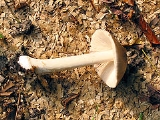
Volvariella
Overview
Genus
In biology, a genus is a low-level taxonomic rank used in the biological classification of living and fossil organisms, which is an example of definition by genus and differentia...
of mushroom
Mushroom
A mushroom is the fleshy, spore-bearing fruiting body of a fungus, typically produced above ground on soil or on its food source. The standard for the name "mushroom" is the cultivated white button mushroom, Agaricus bisporus; hence the word "mushroom" is most often applied to those fungi that...
s with deep salmon pink gills and spore print
Spore print
thumb|300px|right|Making a spore print of the mushroom Volvariella volvacea shown in composite: mushroom cap laid on white and dark paper; cap removed after 24 hours showing pinkish-tan spore print...
s. They lack a ring
Annulus (mycology)
An annulus is the ring like structure sometimes found on the stipe of some species of mushrooms. The annulus represents the remaining part of the partial veil, after it has ruptured to expose the gills or other spore-producing surface. An annulus may be thick and membranous, or it may be cobweb-like...
, and have an Amanita-like volva
Volva (mycology)
The volva is a mycological term to describe a cup-like structure at the base of a mushroom that is a remnant of the universal veil. This macrofeature is important in wild mushroom identification due to it being an easily observed, taxonomically significant feature which frequently signifies a...
at the stem
Stipe (mycology)
thumb|150px|right|Diagram of a [[basidiomycete]] stipe with an [[annulus |annulus]] and [[volva |volva]]In mycology a stipe refers to the stem or stalk-like feature supporting the cap of a mushroom. Like all tissues of the mushroom other than the hymenium, the stipe is composed of sterile hyphal...
base. Some species of Amanita
Amanita
The genus Amanita contains about 600 species of agarics including some of the most toxic known mushrooms found worldwide. This genus is responsible for approximately 95% of the fatalities resulting from mushroom poisoning, with the death cap accounting for about 50% on its own...
look similar, but Amanita
Amanita
The genus Amanita contains about 600 species of agarics including some of the most toxic known mushrooms found worldwide. This genus is responsible for approximately 95% of the fatalities resulting from mushroom poisoning, with the death cap accounting for about 50% on its own...
has white spore
Spore
In biology, a spore is a reproductive structure that is adapted for dispersal and surviving for extended periods of time in unfavorable conditions. Spores form part of the life cycles of many bacteria, plants, algae, fungi and some protozoa. According to scientist Dr...
s and often have a ring. Since the gills of young Volvariella are white at first, they are more easily mistaken for Amanita
Amanita
The genus Amanita contains about 600 species of agarics including some of the most toxic known mushrooms found worldwide. This genus is responsible for approximately 95% of the fatalities resulting from mushroom poisoning, with the death cap accounting for about 50% on its own...
. The genus is estimated to contain about 50 species.
Many sources list Volvariella as a member of the Pluteaceae
Pluteaceae
The Pluteaceae are a family of small to medium-sized mushrooms which have free gill attachment and pink spores. Members of Pluteaceae can be mistaken for members of Entolomatacae but can be distinguished by their angled spores and attached gills...
family, but recent DNA studies have revealed that Pluteus
Pluteus
Pluteus is a large genus of fungi with over 100 species. They are wood rotting saprobes with pink spore prints and gills that are free from the stem.Pluteus means shed or penthouse.-Characteristics of the genus :...
and Volvariella evolved separately and have very different DNA.
Unanswered Questions

